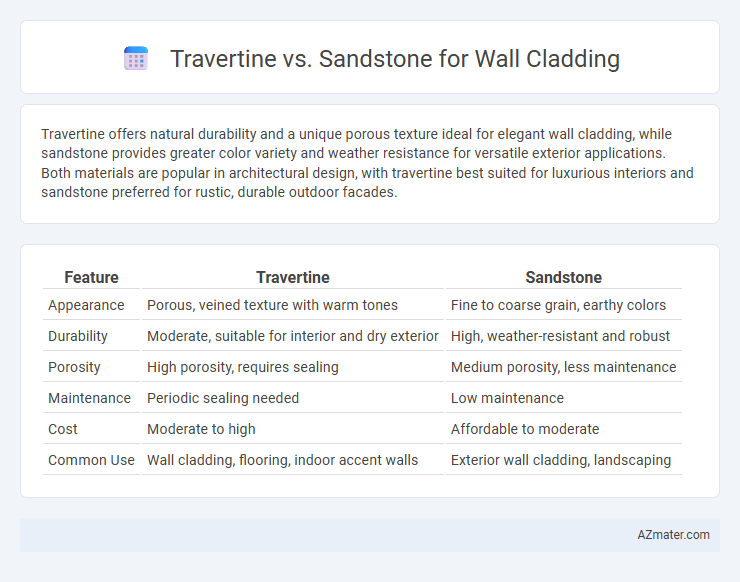Travertine offers natural durability and a unique porous texture ideal for elegant wall cladding, while sandstone provides greater color variety and weather resistance for versatile exterior applications. Both materials are popular in architectural design, with travertine best suited for luxurious interiors and sandstone preferred for rustic, durable outdoor facades.
Table of Comparison
| Feature | Travertine | Sandstone |
|---|---|---|
| Appearance | Porous, veined texture with warm tones | Fine to coarse grain, earthy colors |
| Durability | Moderate, suitable for interior and dry exterior | High, weather-resistant and robust |
| Porosity | High porosity, requires sealing | Medium porosity, less maintenance |
| Maintenance | Periodic sealing needed | Low maintenance |
| Cost | Moderate to high | Affordable to moderate |
| Common Use | Wall cladding, flooring, indoor accent walls | Exterior wall cladding, landscaping |
Introduction to Travertine and Sandstone Wall Cladding
Travertine wall cladding offers a durable and elegant solution with its natural porous texture and warm earthy tones, commonly found in beige, cream, and rusty hues, making it ideal for both indoor and outdoor applications. Sandstone wall cladding is prized for its granular texture and broad color range, including shades of red, brown, and yellow, providing excellent weather resistance and a natural, rustic appearance. Both materials are sedimentary stones, valued for their aesthetic appeal and versatility in architectural designs, yet travertine tends to have a more polished look while sandstone emphasizes rugged charm.
Origins and Formation: Travertine vs Sandstone
Travertine is a sedimentary rock formed primarily from calcium carbonate deposits in mineral-rich hot springs and limestone caves, resulting in its characteristic porous texture and natural veining. Sandstone, composed mainly of compacted sand-sized mineral particles, originates from the accumulation and cementation of sand in riverbeds, beaches, or deserts over millions of years. Both stones showcase unique geological formation processes, influencing their durability and aesthetic suitability for wall cladding applications.
Aesthetic Appeal and Color Variations
Travertine offers a distinctive aesthetic appeal with its natural pitted texture and warm, earthy tones ranging from beige to honey, creating a timeless and elegant look for wall cladding. Sandstone provides a broader spectrum of color variations including reds, yellows, browns, and greys, allowing for greater customization and vibrant design options. Both stones enhance architectural spaces, but travertine's subtle veining contrasts with sandstone's layered sedimentary patterns to suit different style preferences.
Surface Texture and Finish Options
Travertine offers a naturally pitted, porous surface that can be honed, polished, or left rough for a textured, rustic appearance, making it ideal for elegant wall cladding. Sandstone features a more granular, coarse texture with a matte finish, providing a rugged, earthy aesthetic that enhances outdoor and natural-themed walls. Both materials allow customization in surface finish, but travertine's smooth options deliver a refined look, whereas sandstone emphasizes tactile depth and durability.
Strength and Durability Comparison
Travertine offers greater strength and resilience compared to sandstone, making it a preferred choice for wall cladding in high-traffic or exterior environments. Its dense, compact structure provides superior durability against weathering, erosion, and mechanical stresses, while sandstone, being softer and more porous, tends to wear faster and require more maintenance. The mineral composition of travertine contributes to enhanced compressive strength, making it ideal for long-lasting, load-bearing cladding applications.
Weather Resistance and Maintenance Needs
Travertine offers superior weather resistance compared to sandstone, as its dense structure makes it less porous and more durable against moisture and temperature fluctuations, making it ideal for exterior wall cladding in harsh climates. Sandstone, while aesthetically pleasing with its natural grain patterns, requires regular sealing and maintenance to prevent erosion and water absorption, which can lead to discoloration and surface degradation over time. Choosing travertine over sandstone reduces long-term upkeep costs and enhances the longevity of wall cladding in environments exposed to rain, frost, and UV radiation.
Installation Requirements and Techniques
Travertine requires precise cutting and sealing due to its porous nature, demanding careful handling to prevent surface damage during wall cladding installation. Sandstone's softer texture allows easier cutting but necessitates reinforcement with appropriate adhesives to ensure strong adhesion and durability on vertical surfaces. Both materials benefit from professional installation techniques such as using proper backer boards and grout sealing to enhance longevity and maintain aesthetic appeal.
Cost Comparison: Travertine vs Sandstone
Travertine wall cladding typically costs between $20 to $45 per square foot, reflecting its natural durability and polished finish. Sandstone, being more abundant and easier to quarry, generally ranges from $15 to $35 per square foot, making it a more budget-friendly option. Installation costs are comparable, but travertine's density may require more labor, slightly increasing overall expenses compared to sandstone.
Environmental Impact and Sustainability
Travertine, a natural limestone deposited by mineral springs, is considered more sustainable due to its abundant availability and lower processing emissions compared to sandstone, which requires more energy-intensive quarrying and processing. Sandstone's extraction often disrupts local ecosystems and generates higher particulate pollution, making it less environmentally friendly for wall cladding applications. Both materials are durable and long-lasting, but travertine's lower environmental footprint and recyclability provide a greener choice for sustainable building projects.
Choosing the Right Stone for Your Project
Travertine offers a distinctive porous texture and natural veining that enhances aesthetic appeal, making it ideal for elegant wall cladding projects, while sandstone provides durability and a wide range of earthy colors suitable for rustic or traditional designs. Consider environmental factors such as moisture exposure and climate, as travertine is more susceptible to weathering and requires sealing, whereas sandstone boasts higher resistance to harsh conditions. Select the stone that best aligns with your project's visual style, maintenance preferences, and longevity requirements to ensure optimal performance and beauty.

Infographic: Travertine vs Sandstone for Wall Cladding
 azmater.com
azmater.com